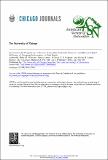Files in this item
Environmental complexity influences association network structure and network-based diffusion of foraging information in fish shoals
Item metadata
| dc.contributor.author | Webster, Michael Munro | |
| dc.contributor.author | Atton, Nicola | |
| dc.contributor.author | Hoppitt, William John Edward | |
| dc.contributor.author | Laland, Kevin Neville | |
| dc.date.accessioned | 2014-08-05T09:31:01Z | |
| dc.date.available | 2014-08-05T09:31:01Z | |
| dc.date.issued | 2013-02 | |
| dc.identifier | 49268815 | |
| dc.identifier | e06d2f9f-212e-42ea-babe-d99f818f3ad8 | |
| dc.identifier | 000314091200010 | |
| dc.identifier | 84873046358 | |
| dc.identifier.citation | Webster , M M , Atton , N , Hoppitt , W J E & Laland , K N 2013 , ' Environmental complexity influences association network structure and network-based diffusion of foraging information in fish shoals ' , American Naturalist , vol. 181 , no. 2 , pp. 235-244 . https://doi.org/10.1086/668825 | en |
| dc.identifier.issn | 0003-0147 | |
| dc.identifier.other | ORCID: /0000-0001-9597-6871/work/60427817 | |
| dc.identifier.other | ORCID: /0000-0002-2457-0900/work/60630403 | |
| dc.identifier.uri | https://hdl.handle.net/10023/5082 | |
| dc.description | This project was funded by grants from the Natural Environment Research Council (NE/D010365/1) and the European Research Council (EVOCULTURE 232823) to K.N.L. | en |
| dc.description.abstract | Socially transmitted information can significantly affect the ways in which animals interact with their environments. We used network-based diffusion analysis, a novel and powerful tool for exploring information transmission, to model the rate at which sticklebacks (Gasterosteus aculeatus) discovered prey patches, comparing shoals foraging in open and structured environments. We found that for groups in the open environment, individuals tended to recruit to both the prey patch and empty comparison patches at similar times, suggesting that patch discovery was not greatly affected by direct social transmission. In contrast, in structured environments we found strong evidence that information about prey patch location was socially transmitted and moreover that the pathway of information transmission followed the shoals' association network structures. Our findings highlight the importance of considering habitat structure when investigating the diffusion of information through populations and imply that association networks take on greater ecological significance in structured than open environments. | |
| dc.format.extent | 10 | |
| dc.format.extent | 710835 | |
| dc.language.iso | eng | |
| dc.relation.ispartof | American Naturalist | en |
| dc.subject | contagion | en |
| dc.subject | social information | en |
| dc.subject | Preferences | en |
| dc.subject | public information | en |
| dc.subject | Habitat | en |
| dc.subject | Predation risk | en |
| dc.subject | Poecilia-Reticulata | en |
| dc.subject | Behavior | en |
| dc.subject | social learning | en |
| dc.subject | Threespine stickleback | en |
| dc.subject | social network | en |
| dc.subject | social transmission | en |
| dc.subject | Stickleback gasterosteus-aculeatus | en |
| dc.subject | 3-spined sticklebacks | en |
| dc.subject | Social networks | en |
| dc.subject | QH301 Biology | en |
| dc.subject.lcc | QH301 | en |
| dc.title | Environmental complexity influences association network structure and network-based diffusion of foraging information in fish shoals | en |
| dc.type | Journal article | en |
| dc.contributor.sponsor | NERC | en |
| dc.contributor.sponsor | European Research Council | en |
| dc.contributor.sponsor | BBSRC | en |
| dc.contributor.institution | University of St Andrews. School of Biology | en |
| dc.contributor.institution | University of St Andrews. Scottish Oceans Institute | en |
| dc.contributor.institution | University of St Andrews. Institute of Behavioural and Neural Sciences | en |
| dc.contributor.institution | University of St Andrews. Centre for Social Learning & Cognitive Evolution | en |
| dc.contributor.institution | University of St Andrews. Centre for Biological Diversity | en |
| dc.identifier.doi | 10.1086/668825 | |
| dc.description.status | Peer reviewed | en |
| dc.identifier.grantnumber | NE/D010365/1 | en |
| dc.identifier.grantnumber | en | |
| dc.identifier.grantnumber | BB/I007997/1 | en |
This item appears in the following Collection(s)
Items in the St Andrews Research Repository are protected by copyright, with all rights reserved, unless otherwise indicated.

